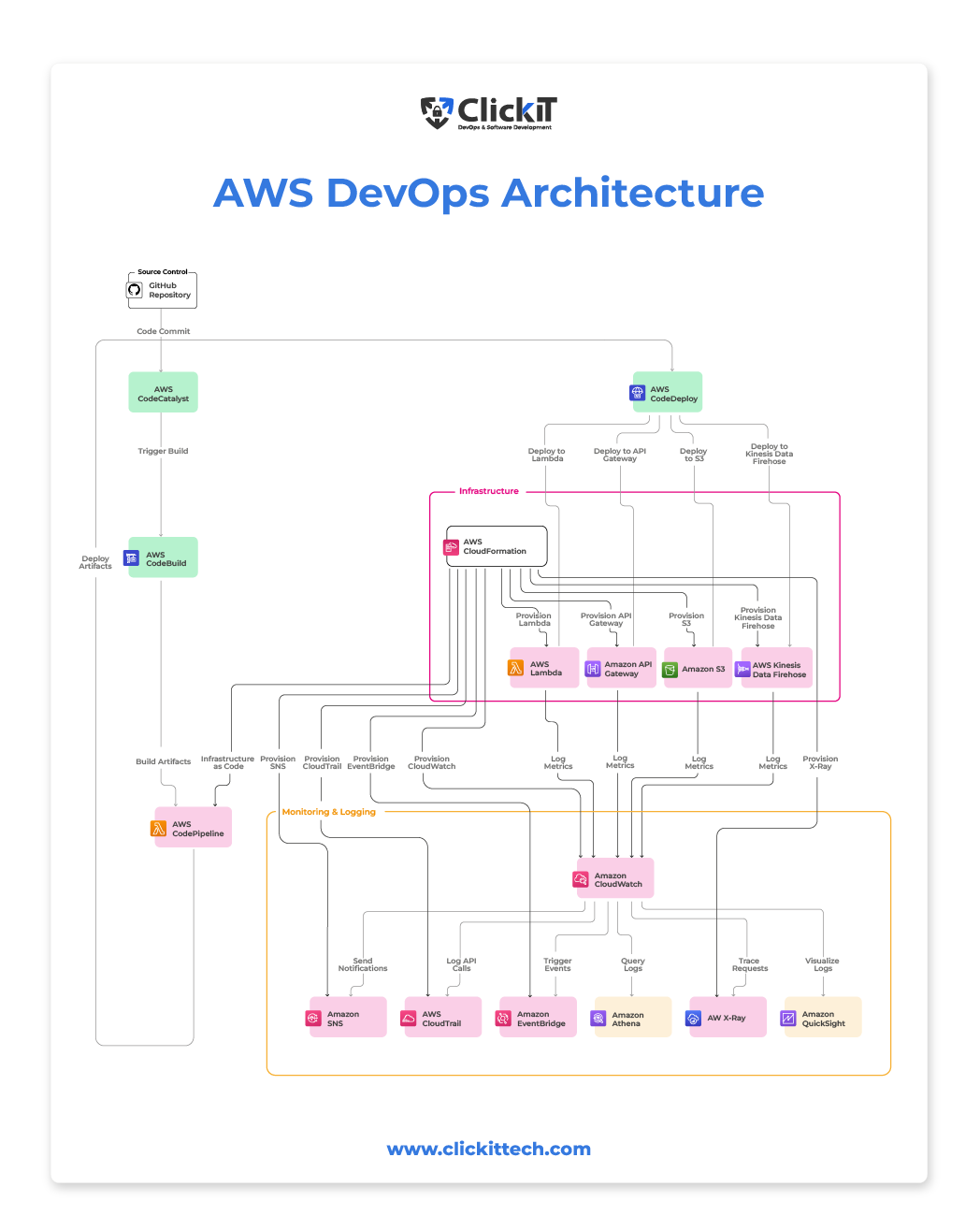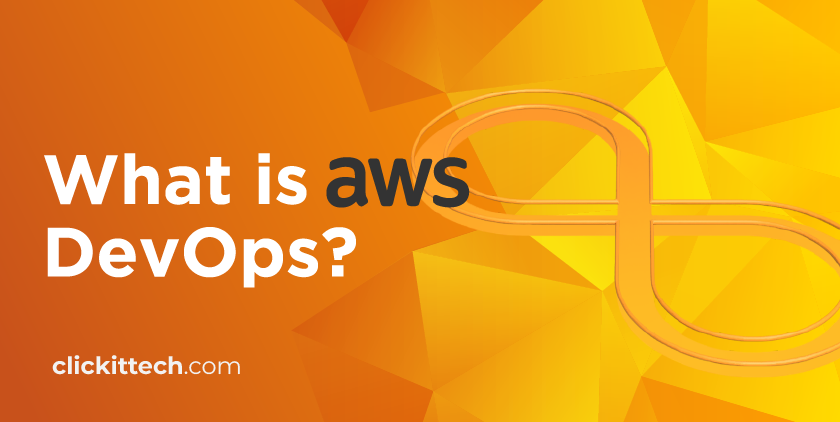AWS DevOps has recently become a trending topic in IT circles as it offers companies the best of both worlds. Since its advent in 2008-2009, DevOps has quickly evolved to take center stage in the IT operations of most companies.
It is no surprise that AWS leads the cloud computing providers’ space as the company is adept at monitoring marketing trends and customer needs to build the right products for the right projects at the right time. AWS DevOps is a perfect example of the company’s vision. This blog answers what DevOps on AWS is, how it works, and its architecture.
- What is AWS DevOps?
- AWS DevOps Architecture
- Use Cases of AWS DevOps
- Benefits of DevOps on AWS
- FAQs
What is AWS DevOps?
AWS DevOps offers a comprehensive suite of tools and practices that enable organizations to automate and streamline software development operations. Simply put, AWS DevOps is running DevOps using AWS tools. The goal of running DevOps on AWS is to leverage the power of AWS’s cloud infrastructure to adopt DevOps practices that accelerate software delivery while maintaining high standards of quality and security.
AWS offers a suite of DevOps tools such as AWS CodePipeline, AWS CodeBuild, and AWS CodeDeploy that allow teams to automate the entire CI/CD pipeline. AWS CodeCatalyst is a unified software development service that streamlines the CI/CD process. In addition, services like AWS CloudFormation and AWS OpsWorks enable infrastructure automation, allowing teams to manage and provision resources in a consistent and repeatable manner.
AWS also provides robust monitoring and logging services such as Amazon CloudWatch and AWS CloudTrail to help teams maintain visibility into application performance and infrastructure health while ensuring that issues are detected and resolved quickly.
The AWS DevOps framework enables organizations to build and deliver high-quality software at higher velocity using the AWS cloud platform by combining tools, practices, and cultural philosophies.
Key Components of AWS DevOps
Organizations need to understand what AWS DevOps is and how running DevOps on AWS makes a difference. Here are a few key reasons:
- DevOps promotes a cultural shift wherein cross-functional teams collaborate and coordinate on projects to break down silos and increase productivity and innovation.
- DevOps automates and streamlines the entire software delivery process, so organizations can release new features and updates more frequently to stay competitive.
- DevOps enables automated testing and continuous integration/continuous deployment pipelines to deliver quality software faster and better. It reduces the risk of errors and downtimes while increasing customer satisfaction.
- DevOps makes it easy to automatically scale and manage applications on-demand to meet changing business needs while not compromising performance.
- With automated processes and efficient resource management, DevOps on AWS helps organizations reduce operational costs and increase ROI over time.
- DevOps integrates security into DevOps pipelines, making security an integral part of the software development lifecycle. With robust security features and compliance certifications, organizations can easily manage security and compliance.
| Cultural Shift | Practices | Tools & Services |
| 1. Better Collaboration between Development and Operations teams 2. Shared responsibility across the SDLC | 1. Continuous Integration (CI) 2. Continuous (Delivery (CD) 3. Infrastructure as Code (IaC) 4. Monitoring and Logging 5. Security & Compliance | 1. AWS CodePipeline (Software Release Workflows) 2. AWS CodeBuild (Build and Test Code) 3. AWS CodeDeploy (Deploy Automation) 4. AWS CodeStar (Unified CI/CD Projects) 5. AWS CloudFormation (Templated Infrastructure Provisioning) 6. AWS OpsWorks (Chef Configuration Management) 7. Amazon CloudWatch (Cloud & Network Monitoring) 8. AWS Identity and Access Management (IAM) 9. AWS Key Management Service (KMS) |
AWS DevOps Architecture
Continuous Integration and Continuous Deployment / Delivery (CI/CD) is the heart of the AWS DevOps architecture.
Continuous Integration is a software development practice in which code changes are automatically tested and frequently integrated into a shared repository. This approach helps identify bugs early and ensures that software is maintained in a deployable state.
Continuous Delivery is a software development practice wherein code changes are automatically tested and prepared for release to production. Continuous deployment extends this practice by automatically deploying every code that passes all tests and quality checks to production.
The AWS DevOps architecture comprises a series of stages that automate and streamline the software development lifecycle.
Here is an overview of the basic stages and key components of each stage in a standard AWS DevOps architecture:

Plan
The planning phase begins with the development teams defining the project requirements, objectives and timelines. This includes identifying the features to be developed, milestones to set and preparing the entire software development lifecycle/
- AWS Project Management Tools: Teams can integrate issue tracking, project tracking and collaboration tools like Zira and Confluence with AWS services to plan, manage and monitor the development lifecycle.
- AWS CloudFormation is a popular Infrastructure-as-Code (IaC) tool that enables teams to describe and manage infrastructure as code using templates.
- AWS CodeCatalyst is a next-gen tool that unifies CI/CD tools, bringing tools like CodeBuild, CodePipeline, CodeStar etc., into a single interface and thereby enabling teams to manage code from a centralized place.
Code
In this phase, code is written and stored in a version control system. A source control/version control tool tracks and manages code changes while helping resolve conflicts that might occur when code is merged from multiple sources.
- GitHub Repository: It acts as a central place to manage source code, track changes and manage version history, allowing multiple developers to write and store code while seamlessly collaborating on the project.
- GitLab and BitBucket are popular version control systems that help you with this purpose.
Build
In this phase, the code written by developers is compiled and transformed into executable software.
- AWS CodeBuild: It is a fully managed build service that automates the Build process. It compiles source code, runs tests and creates software packages that are ready for deployment.
Test
In this phase, the code is subjected to automated tests to ensure it is functional and ready to be deployed.
- AWS CodeBuild (Extended): The automation of the Build process includes running tests to validate that the code behaves as expected. This includes unit tests, integration tests and other tests to identify issues early in the development process.
Release
The release phase involves orchestrating the deployment of code to various environments such as staging, development and production.
- AWS CodePipeline: AWS CodePipeline automates this process by enabling code to move from one stage to another with all necessary checks.
Deploy
As a part of the release process, the deployment phase involves deploying application artifacts to servers, cloud platforms, and other infrastructure components to be accessible to users. It includes environment preparation, deployment of artifacts, configuration management, post-deployment checks, release strategies and rollback mechanisms.
- AWS CodeDeploy: AWS CodeDeploy manages the deployment of applications to target environments such as Amazon EC2, AWS Lambda and on-premise services. Teams can implement deployment strategies such as blue/green deployments, rolling updates and integrating with on-premise servers.
- AWS Lambda: AWS Lambda is a serverless computing tool that can be deployed as a part of the application to handle specific tasks or microservices. It offers scalable, event-driven processing without the need to manage the underlying servers.
- Amazon API Gateway: When an application includes APIs, the Amazon API Gateway deploys and manages these APIs which means a scalable and secure entry point for client requests.
Operate
The operation phase focuses on maintaining, monitoring, and managing an application that is deployed to a production environment. This approach ensures that the application is always available, performing and reliable. Teams can address any issues that arise during operations as well.
- Amazon S3: Applications in operations need to store and retrieve data. Amazon S3 is a highly popular scalable object storage for static assets, backups, logs and other critical data required by an application.
- Amazon Kinesis Data Firehose: This service streams real-time data to different environments like Amazon S3 and Amazon Redshift for processing and analyzing it on the go.
Monitor
This phase involves continuous tracking of the performance, availability, and health of applications and their infrastructure. It includes collecting and analyzing logs, responding to incidents, managing capacity and security, ensuring backup and recovery, and providing user support and feedback.
- Amazon CloudWatch: The tool collects and tracks metrics logs and event data and provides real-time insights into application performance and health.
- Amazon Athena & Amazon QuickSight: These tools offer advanced analytics. Amazon Athena helps teams query data stored in Amazon S3, while Amazon QuickSight visualizes this data in various formats. It offers dashboards and reports that help the business teams make informed decisions.
- Amazon EventBridge: This tool triggers automated responses to events within applications to ensure that issues are resolved quickly and efficiently.
- AWS CloudTrail: It records API calls for auditing and compliance purposes.
- Amazon SNS: It is a simple notification service that sends alerts and notifications
- AWS X-Ray: It is an AWS tool for debugging and analyzing the performance of distributed apps.

Use Cases of AWS DevOps
Here are important use cases of AWS DevOps:
1) Migrating to DevOps on AWS
A large enterprise is migrating its on-premise infrastructure to AWS Cloud and plans to implement DevOps practices as a part of the migration.
- AWS Migration Hub is used to plan and track the migration of applications to AWS.
- GitHub/GitLab and AWS CodePipeline are implemented to replace legacy version control and CI/CD tools to enable CI/CD in the cloud.
- AWS CloudFormation automates the migration of infrastructure components to AWS so that the new environment is consistent with the on-premises environment.
- Amazon S3 and Amazon Kinesis Data Firehose collect, store and analyze data in real-time as applications are migrated.
- Amazon CloudWatch helps teams in monitoring the migrated apps and infrastructure via custom dashboards.
This DevOps on AWS strategy improves collaboration between development and operations teams and increases deployment frequency with reduced errors while enhancing visibility into application performance and infrastructure health.
2) Implementing DevOps from Scratch on AWS
A small business or startup is looking to implement a robust DevOps pipeline from scratch on AWS.
- The development team uses GitHub/GitLab as a source control repository to manage code versions.
- AWS CodePipeline is set up to automate the build, test and deployment process.
- AWS CodeBuild is integrated to compile the code and run unit tests.
- AWS CodeDeploy is used to automate deployments across multiple environments
- AWS CloudFormation is used to automate the provisioning and configuration of infrastructure as code to ensure consistency across environments.
- Amazon S3 and AWS Lambda help in managing static content and serverless functions.
- Amazon CloudWatch is set up to monitor the app and infrastructure and alert teams based on predefined key metrics.
This approach helps small businesses and startups to achieve rapid development and deployment cycles, ensure high availability and performance with consistent and repeatable environments.
3) Security and Compliance with DevOps on AWS
A finance services company wants to implement security checks and compliance monitoring into its DevOps pipeline on AWS to ensure adherence to regulatory requirements such as PCI DSS or GDPR.
- Infrastructure as Code with AWS CloudFormation
- Pre-approved and compliant templates with security best practices such as encryption, least privilege and network segmentation are used.
- Continuous Integration and Continuous Deployment with Security
- AWS CodePipeline for CI/CD automation with security incorporated at every stage.
- AWS CodeBuild is integrated with security tools for static code analysis, dependency scanning and secret detection.
- AWS CodeDeploy to deploy only artifacts that pass all security checks
- Automated Compliance Auditing
- AWS Config and AWS CloudTrail continuously monitor and record changes to the AWS environment while logging all actions.
- AWS Security Hub provides a centralized view of security and compliance status by aggregating security findings from AWS services such as AWS Config and AWS GuardDuty.
- Runtime Security Monitoring
- Amazon Inspector automatically assesses and identifies application vulnerabilities during deployment and at runtime.
- Amazon CloudWatch and AWS Lambda are used to automate the response to security events.
- Encryption and Data Protection
- Amazon S3 is configured with server-side encryption and access control to protect data stored in S3 buckets
- Amazon Key Management Service (KMC) manages encryption keys
- Compliance Reporting and Auditing
- AWS Audit Manager automates the collection of evidence required for audits and generates customized reports.
- Amazon QuickSight is used to visualize compliance metrics and get real-time insights into the security and compliance of the environment.
This approach offers integrated security, continuous compliance, and enhanced visibility into the security posture of the infrastructure while reducing manual effort in software development and business operations.
4) Efficient Management of Cloud Infrastructure with AWS DevOps
A global e-commerce company needs to manage its rapidly growing infrastructure across multiple regions efficiently.
- IaC with CloudFormation
- AWS CloudFormation is used to create reusable templates for common infrastructure components like EC2 instances, VPCs, Load balancers and RDS databases such that provisioned infrastructure is consistent across environments and regions.
- Stacksets within CloudFormation are used to deploy and manage stacks across accounts and regions for
- Automated Provisioning and Configuration
- AWS Service Catalog is used to create and manage catalogs of approved infrastructure templates.
- AWS Systems Manager automates the provisioning and resource management across the cloud environment.
- Continuous Integration and Continuous Deployment / Delivery (CI/CD)
- AWS tools such as AWS CodePipeline, AWS CodeBuild, AWS CodeDeploy and AWS CodeCatalyst are used to set up and manage CI/CD processes.
- Cost Optimization and Resource Management
- AWS Scaling automatically adjusts the capacity of resources on-demand.
- AWS Cost Explorer and AWS Budgets are used to monitor and optimize cloud spending.
- Monitoring and Logging
- Amazon CloudWatch monitors and manages application performance and infrastructure health.
- AWS CloudTrail provides full visibility and traceability for compliance and auditing purposes.
- AWS Config ensures that the infrastructure complies with security standards and company policies.
- Disaster Recovery and Backup
- AWS Backup automates and centralizes the backup of all critical infrastructure resources.
- AWS CloudFormation and Amazon S3 are used to maintain and replicate infrastructure templates and application code across regions and environments.
This approach ensures consistency and reliability of infrastructure across all environments, cost optimization, efficiency and automation, scalability visibility and compliance.

Benefits of DevOps on AWS
a) High Scalability
AWS DevOps leverages the inherent scalability of AWS cloud infrastructure to automatically scale applications based on demand. For instance, AWS Lambda can be triggered by events in the CI/CD pipeline to perform actions such as running custom scripts, processing logs or managing notifications. With services such as AWS Lambda, Amazon EC2, and Amazon S3 and features like auto-scaling groups, elastic load balancers, and serverless computing, organizations can automatically scale apps to ensure high availability, responsiveness, and high performance under varying loads without manual intervention.
b) Security
Security is a key feature of AWS DevOps. It offers various security features and compliance certifications to protect apps and data. For instance, AWS Identity and Access Management (IAM), AWS Key Management Service (KMS), and AWS Cloud Trail equip organizations with robust access control, encryption, and auditing capabilities. Organizations can additionally integrate security into the CI/CD pipeline in the form of DevSecOps and thereby automate security checks and tests to make security an integral part of the development pipeline.
c) Cost Optimization
Organizations can optimize costs by effectively managing AWS resources and processes. For instance, pay-as-you-go pricing models, spot instances, and reserved instances can be strategically used to reduce operational expenses.
Additionally, AWS offers tools like AWS Cost Explorer and AWS Budgets to help organizations monitor and manage cloud spending. Organizations can automate infrastructure provisioning and deployment processes to save costs over time significantly.
d) Automation
Automation holds center stage in AWS cloud operations. AWS offers various tools and services, such as AWS CodePipeline, CodeBuild, and CodeDeploy, to automate and streamline CI/CD pipelines so that software is released quickly and reliably. Automation of the SDLC at various stages ensures faster time to market, increased efficiency, and reduced manual errors.
e) Fully Managed Services
AWS portfolio contains fully managed services that reduce operational burden on teams. Amazon RDS, AWS Fargate, AWS Elastic Beanstalk, and Amazon DynamoDB are key services that handle infrastructure management tasks such as provisioning, scaling, and patching. DevOps on AWS allows teams to focus more on improving the quality of the application without managing the underlying infrastructure.
Conclusion
DevOps on AWS combines cultural practices, tools, and services offered by AWS to provide a comprehensive approach for organizations to efficiently manage the entire software development lifecycle.
By leveraging this framework, organizations can achieve faster time to market, improved software quality, better collaboration across teams, and optimized costs. Overall, AWS DevOps empowers organizations to implement world-class technologies and best practices in the software development space always to be relevant and stay in the competition in today’s rapidly innovating, fast-paced world.
FAQs
Yes, DevOps on AWS can be seamlessly integrated with a wide range of tools and services. For instance, you can integrate AWS CodePipeline with 3rd-party version control systems like GitHub, build tools like Jenkins and configuration management tools like Ansible. These integrations help organizations extend their existing toolchains while leveraging the automation and scalability capabilities of AWS.
AWS DevOps offers seamless integration with the AWS cloud ecosystem, which results in more efficient automation, optimized resource usage, and access to a wide range of AWS services that enhance the entire software development lifecycle.
With DevOps on AWS, it is easy to automate the process of updating applications as you can implement blue/green deployment strategies using AWS CodeDeploy, which results in minimal disruption and downtimes.









